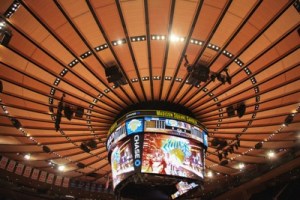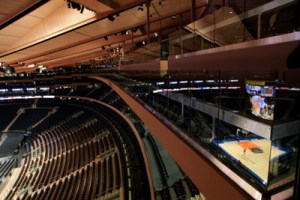Garden State of Mind: Architect Murray Beynon on the Renovation of Madison Square Garden
By Gus Delaporte October 29, 2013 10:00 am
reprints
 The Chase Bridges were perhaps the most controversial part of the transformation. Were you ever concerned that they wouldn’t be well received?
The Chase Bridges were perhaps the most controversial part of the transformation. Were you ever concerned that they wouldn’t be well received?
We did two full-scale mock-ups, not just to try out the bridge but also gauge the impact on all the seats underneath and behind. We did countless renderings and were absolutely sure the sight lines would work. It was really the full-scale models that gave us the confidence that these were an enhancement and did not interfere with the seats behind.
As part of the construction of the bridges, you needed to install dampeners to control movement. Can you describe those and how they work?
First of all, there is no structural issue here at all. People could jump up and down, and there would not be an issue. What we installed were tuned mass dampeners and applied them on each of the bridges. They weigh approximately 9,000 pounds each and move in countermotion to crowds jumping up and down, etcetera.
They have been used now in the industry for 20 or 25 years. The Grand Canyon Skywalk—they’re in that. They’re at the top of the Bloomberg Tower. They’ve never been used on bridges in an arena, because there are no other bridges like these in an arena. But they’ve been well tested, and they’re an amazing mechanism.
How challenging was it to essentially create an entirely new arena within the bones of the existing Madison Square Garden structure?
You do the same thing as any new building. You work out exactly what the client’s objectives are. Normally, with a new building, you then start laying it out. But obviously it’s different here, because you’re dealing with a set structure and a set budget. The problem is essentially double in the level of difficulty, because there are some things that you simply cannot move. I think it doubled the amount of meetings with people, because we are big believers that the best input comes from many sources. It’s one of the reasons it took longer in the planning stages.
Prior to the renovation, there were some seats that had obstructed views of the action. Are there any obstructed view seats in the Garden now?
No. There are a few—or some—that can’t see the full scoreboard, but we have put in a large screen on the back of the bridges, and in some corners we put quite large televisions to duplicate the information on the scoreboard.
There is quite a bit of the Garden’s history celebrated throughout the building. How important was that to the process?
The Garden with its history and its iconic stature—there was no question ever that we weren’t going to celebrate the past. We realized we couldn’t just create a Hall of Fame and we realized we probably didn’t want just a single room. The fact is we just had too much. We wanted to celebrate the history, the events and the teams’ histories. That quickly became a major theme and something that has been done very well.
Did you incorporate fan input?
The thing that the Garden insisted on at the outset was that we talk to New Yorkers. I went through 33 hours worth of focus group sessions, and we did it with Ranger fans, Knick fans and Liberty fans and with people that never come to the Garden. We went through 33 of those probing what the Garden meant to them, and I can point to many things in the building that came from that—I really can. That, I think, was a key starting point that got us on the right track.


